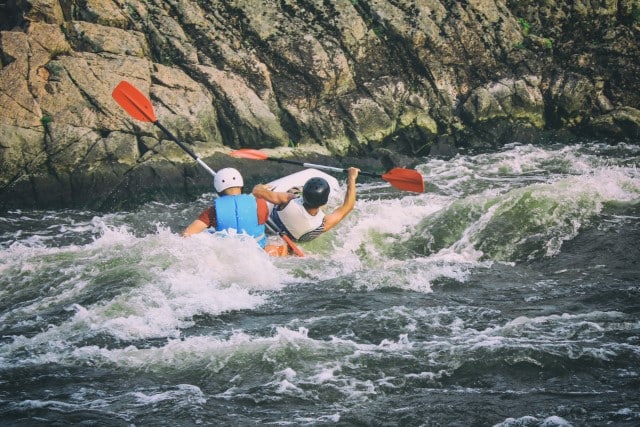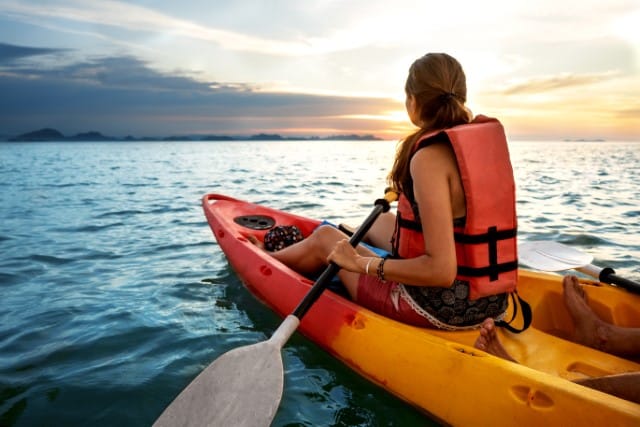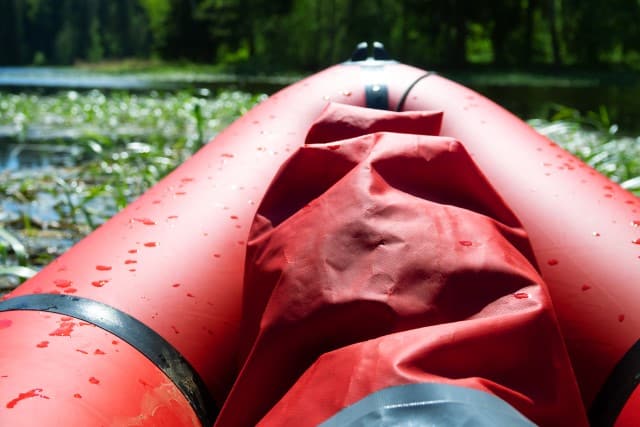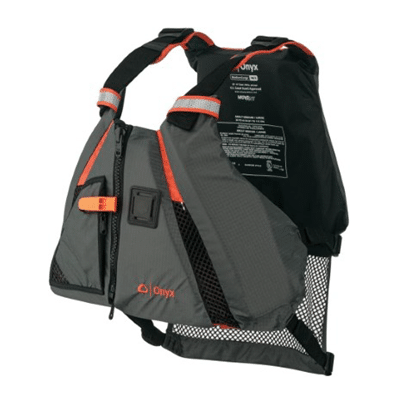Just getting started as a kayaker? You probably have some concerns. One of the most common questions is can a kayak sink? There are many different types of kayaks, and paddlers worry about how seaworthy their kayak is if it tips or they roll it. Whenever too much water gets into a kayak, it may sink, but whether or not a kayak will sink depends upon the construction of your kayak. There are also some things you can do to stay safe while kayaking and to prevent your kayak from sinking if you do capsize.
There are certain circumstances in which a kayak can sink. Let’s discuss how to tell if a kayak will sink if submerged, or if it will remain afloat. We’ll also take a look at tools and devices like kayak float bags that can help keep a kayak afloat.
Difference Between Sit-Inside and Sit-on-Top Kayaks
There is a big difference between sit-inside and sit-on-top kayaks in terms of whether they can sink. If you have a sit-on-top kayak and there aren’t any holes in it, then it cannot sink. That is because there isn’t a crevice where water can get in and overwhelm the watercraft.

Sit-inside kayaks with cockpits, however, may sink in certain circumstances. Water can get into the cockpit and accumulate there. If your sit-inside kayak lacks bulkheads, it’s even more likely to sink. That’s because bulkheads help with buoyancy.
How Can I Prevent Water Taking Over My Sit-Inside Kayak?
Your sit-inside kayak may sink if too much water gets into its cockpit. Ensure that your kayak has bulkheads, which will add buoyancy and cut down on the risk of sinking. If you want a sit-inside kayak, look for one featuring sealed hatches.
Sealed hatches are storage spaces that you can seal off. Make sure you do so before you go on the water, as the air that is trapped inside them will help prevent sinking. Why? Well, these sealed areas mean water cannot fill up your entire cockpit. This is true even in situations where a kayak capsizes.
What to Do if Your Kayak Capsizes
It’s when a kayak capsizes that there’s the highest chance of sinking, especially if you don’t have the right kind of kayak (as we discussed earlier). Like I mentioned before, if you have a sit-inside kayak, you should have one that includes sealed hatches in the cockpit, as well as bulkheads.

What does capsize mean? When a kayak capsizes, it flips over and pushes you into the water. Once you’ve been tossed into the water, the kayak may sink if you haven’t taken the necessary precautions.
For example, it may sink if the cockpit completely fills with water, and you don’t have sealed hatches. You should do safety training and learn how to do a wet exit before you go out on the water.
Stay Close to Shore
If you fall into the water and your kayak ends up sinking, this could be an extremely dangerous situation. This is especially true if you’re far away from shore. After all, you may be too far away to reach land by swimming, or you may be injured and unable to do so. An example could be if you hit your head on an object.
This is why you should make sure your kayak has the right design and features to prevent sinking before you go out on the water. If your kayak ever does capsize, you must stay calm and do certain things in order to stay safe and get back into your boat.
Wear a Personal Floatation Device
Always wear a personal flotation device (PFD) when you go kayaking. This way, you will float in the water instead of sinking.

Don’t go kayaking until you have taken a kayaking course with a certified instructor. You should learn all the procedures for what to do if you have an emergency in the water, such as capsizing, before you begin kayaking.
You must learn how to extricate yourself from the capsized kayak, which can be an especially tricky and stressful (and dangerous) situation if the kayak has flipped upside down.
What Are Kayak Float Bags?
Kayak float bags are a popular kayaking tool that will help keep your kayak afloat. While not every kayaker uses kayak float bags, if you’re a beginner, you should probably consider having them.

A kayak float bag is generally made of a material like nylon coated with urethane. They are filled with air like balloons, and often have a triangular shape.
Put kayak float bags in the far edges of your kayak’s bow. You should also place them in the stern of your watercraft. Kayak float bags give your kayak better buoyancy and resistance to sinking.
Kayakers venturing to more challenging environments, such as whitewater kayaking, should always have float bags in their kayaks.
Types of Kayak Float Bag
There are several different kinds of kayak float bags available on the market. The most popular kinds are made of urethane and vinyl. Many of the best float bags are vinyl that is coated with urethane. Don’t go too cheap when purchasing kayak float bags. This is an important investment in your safety and well-being.
There are single-piece and split-float varieties of float bags you can find and purchase. A single-piece float bag is just one bag that is inflated with air. It will be designed for either the stern or the bow. Find out which part of the kayak the bag is designed for before you buy it.
Many kayakers go with split-floats. Split-float kayak float bags are appropriate if your kayak features support pillars. Does your kayak have support pillars? If so, you should get this type of float bag. It’s because you cannot accommodate a single-piece float in a kayak hull that has support pillars.
Prevent Kayak Damage
Keeping your kayak damage-free is an important part of kayak safety. If your watercraft is ever damaged, get it fixed before venturing back out onto the water. It’s especially vital to regularly inspect the hull, ensuring there’s no damage.

When I got my first kayak, I was surprised to learn incorrect storage can lead to damage. Inappropriate storage can lead to significant hull damage, and this will make you unsafe on the water. Many kayakers have ended up in dangerous situations because of unnoticed hull damage.
Your kayak should never be stored on hard surfaces. If a kayak is left on on this kind of surface for a significant amount of time (for example, two or three days), the hull is likely to get damaged. You must also properly clean your kayak before putting it in storage.
You can damage your kayak by leaving residue and dirt on it. Usually, a mixture of water and a mild detergent will be appropriate for spraying on your kayak for cleaning. Make sure to buff and rinse once you’re done.
Be thorough when you clean your kayak, referring to the directions you got when you purchased the boat. If you have boat cleaning services in the area, ask one of them for a quote if you don’t want to do the cleaning yourself.
Keep your kayak stored somewhere with a lot of shade. It should never be left for days in the sun.
Yes, a Kayak Can Sink
As we’ve seen here, a kayak may indeed sink if you haven’t taken the necessary precautions. A sinking kayak can be a dangerous situation, especially if you are far from shore. Ensure that if your kayak capsizes (flips over) that it will not sink.



